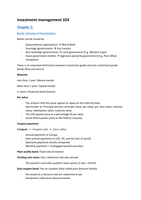Investment management 324
Chapter 1:
Bonds: Overview of characteristics
Bonds can be issued by:
- Supranational organisations World Bank
- Sovereign governments Any country
- Non-sovereign governments Local government (E.g. Western Cape)
- Quasi-government entities Agencies owned by government (E.g. Post office)
- Companies
There is an important distinction between investment grade and non-investment grade
bonds (Risk and return)
Maturity
Less than 1 year: Money market
More than 1 year: Capital market
∞ years: Perpetual bond (Scarce)
Par value
- The amount that the issuer agrees to repay on the maturity date
- Also known as: Principle amount, principle value, par value, par, face value, nominal
value, redemption value, maturity value
- The USA quotes price as a percentage of par value
- South Africa quotes price as the Yield to maturity
Coupon payments
𝑪𝒐𝒖𝒑𝒐𝒏 = 𝐶𝑜𝑢𝑝𝑜𝑛 𝑟𝑎𝑡𝑒 × 𝑓𝑎𝑐𝑒 𝑣𝑎𝑙𝑢𝑒
- Annual payments in Europe
- Semi-annual payments in USE, UK, and SA (rest of world)
- Quarterly payments mostly companies
- Monthly payments = mortgaged backed securities
Plain vanilla bond: Fixed rate of interest
Floating rate notes: Pay a reference rate plus spread
- The spread is normally quoted in basis points (1 bps = 0.01%)
Zero coupon bond: Pay no coupons (Also called pure discount bonds)
- Are issued at a discount and are redeemed at par
- Sometimes called pure discount bonds
,Reference rates
Libor (London interbank offered rate) is widely used
- Euribor = Euro bank
- Hibor = Hong Kong
- Sibor = Singapore
- Jibar = SA
Jibar:
- The Johannesburg interbank agreed rate is the money market rate in SA
- It is calculated as the average interest rate at which banks buy and sell money
- This rate is calculated daily by the SA futures exchange as the average price lending
rate quoted independently by a number of different banks
- The rate is available in one-month, three-month, six-month, and twelve-month
discount terms
- The three-month rate is used as a benchmark of short-term interest rate movements
Duel currency bonds: Make coupon payments in one currency and pay the principle in
another
Currency option bonds: Gives bondholders the option to choose the currency in which they
want to receive payments (For each payment)
Yield measures
𝐶𝑜𝑢𝑝𝑜𝑛
𝐶𝑢𝑟𝑟𝑒𝑛𝑡 𝑦𝑖𝑒𝑙𝑑 = 𝑃𝑟𝑖𝑐𝑒
𝑌𝑖𝑒𝑙𝑑 𝑡𝑜 𝑚𝑎𝑡𝑢𝑟𝑖𝑡𝑦 = 𝐼𝑅𝑅 𝑜𝑓 𝑐𝑎𝑠ℎ 𝑓𝑙𝑜𝑤𝑠
Legal, regulatory, and tax considerations (pg. 10)
Bond indenture
- Also called the trust deed (Legal contract)
- It specifies the features of the bond, the issuer, collateral (assets or guarantees)
credit enhancements, and covenants (Rights of bondholders, actions the issuer is
obligated to perform or prohibited from performing)
- The trustee verifies
Sources of repayment proceeds
Sovereign bonds: Taxes, ability to print money
Non-sovereign bonds: Government debt; general tax base, specific project, specific taxes
Corporate bonds: Operational cash flow
Securitisations: Cash flows from specific assets
,Collateral
- Secured bonds are backed by assets or financial guarantees
- Unsecured bonds have no collateral; bond holders have only a general claim
to the issuer’s assets
- Unsecured bonds are paid after secured bonds (Secured have lower credit risk)
- Debentures are a type of bond that can be secured or unsecured (Depends on jurisdiction),
but are generally unsecured
- Mortgage backed securities (MBS) are debt obligations that represent claims to the
cash flows from pools of mortgage loans (Special purpose vehicle)
- Covered bonds are debt obligations backed by a segregated pool of assets called a
“cover pool”
- Credit enhancement refers to a variety of provisions that can be used to reduce the
credit risk of a bond issue
- They offer additional collateral, insurance, or a third party guarantee that the
issuer will meet its obligations
- Can be from internal or external sources
Covenants
- Bond covenants are legally enforceable rules that borrowers and lenders agree on at
the time of issue
- Affirmative covenants specify things the issuer must do
- Usually administrative, pay interest, pay taxes, report
- Negative covenants specify things the issuer may not do
- Usually to restrict actions that increase risk, such as borrowing more money,
paying dividends, selling assets, new investments, mergers and acquisitions
Global bond markets
Domestic bond market:
- Domestic issuer
- Local currency
- Locally traded
- Local rules (Jurisdiction)
,Foreign bond market:
- Foreign issuer
- E.g. Yankee bond, Samurai bond, Kangaroo bond
External bond market (Eurobond market):
- 1960s: Restrictive regulations in the USA bond market
- Eurobond market underwritten by a syndicate of institutions from different
jurisdictions
- “Euro” refers to “External”, not to the currency
- E.g. Eurodollar, Euroyen Euro denominated Eurobond
- Less regulated, bearer bonds, not registered by trustee
- Bearer bonds have no specific owners (I.e. whoever ‘bears’ the bond owns it)
- Not issued to investors in the USA, mostly investors from Europe, Middle East, and
Asia Pacific
Tax:
- Usually coupons taxed as income, changes in value as capital gains (when sold)
- Some bonds are tax free (E.g. municipal bonds in the USA)
- Bonds at a discount: Some portion of the discount is included in income every year
(USA)
Structure of a bond’s cash flow (pg. 23)
Principle repayment
Normal pattern (Bullet bond):
- Periodic coupons
- Entire payment of principle occurs at maturity
, Fully amortised bond:
- Even cash flows throughout
Partially amortised bond:
- Higher coupons than normal, but less than amortised
- End capital repayment is reduced (Balloon payment)
Sinking fund provision
- Plan to set aside funds to retire the bond
- Originally, a sinking fund was a separate cash reserve
- Now, either:
- Retire a set percentage of the bonds each year (Lottery)
- Reduce the principle annually according to a set schedule




